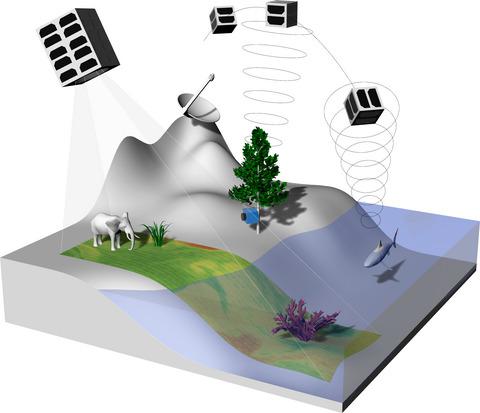当前位置:
X-MOL 学术
›
Remote Sens. Ecol. Conserv.
›
论文详情
Our official English website, www.x-mol.net, welcomes your
feedback! (Note: you will need to create a separate account there.)
SmallSats: a new technological frontier in ecology and conservation?
Remote Sensing in Ecology and Conservation ( IF 3.9 ) Pub Date : 2021-10-01 , DOI: 10.1002/rse2.239 David J. Curnick 1 , Alasdair J. Davies 2 , Clare Duncan 1, 3 , Robin Freeman 1 , David M. P. Jacoby 1, 4 , Hugo T. E. Shelley 5 , Cristian Rossi 6 , Oliver R. Wearn 1, 7 , Michael J. Williamson 1, 8 , Nathalie Pettorelli 1
Remote Sensing in Ecology and Conservation ( IF 3.9 ) Pub Date : 2021-10-01 , DOI: 10.1002/rse2.239 David J. Curnick 1 , Alasdair J. Davies 2 , Clare Duncan 1, 3 , Robin Freeman 1 , David M. P. Jacoby 1, 4 , Hugo T. E. Shelley 5 , Cristian Rossi 6 , Oliver R. Wearn 1, 7 , Michael J. Williamson 1, 8 , Nathalie Pettorelli 1
Affiliation

|
We are in the midst of a revolution in satellite technology, with the rapid development and advancement of small satellites (or SmallSats, i.e., satellites <180 kg). Here, we review the opportunities and challenges that such technology might afford in the field of conservation and ecology. SmallSat constellations may yield higher resolutions than those that are currently available to scientists and practitioners, increasing opportunities to improve environmental-monitoring and animal-tracking capabilities. They may cut access costs to end users, by reducing operational costs and bringing increased competition to the existing market. Their greater flexibility and affordability may moreover enable the development of bespoke constellations for specific conservation and ecological applications, and provide greater interoperability with ground-based sensors, such as tracking devices and camera traps. In addition, SmallSats may serve as cost-effective research and development platforms for new components and products. Combined, these benefits could significantly improve our ability to monitor threats to the environment as they unfold, while enhancing our understanding of animal ecology and ecosystem dynamics. However, significant hardware and software developments are required before such technology is able to produce, process and handle reliable and cost-effective data, and the initial research and development costs still represent a major challenge. Further, we argue that much remains to be done to ensure these new data products become accessible, equitable and sustainable.
中文翻译:

SmallSats:生态和保护的新技术前沿?
随着小型卫星(或 SmallSats,即小于 180 公斤的卫星)的快速发展和进步,我们正处于卫星技术革命之中。在这里,我们回顾了此类技术在保护和生态领域可能带来的机遇和挑战。SmallSat 星座可能会产生比科学家和从业人员目前可用的分辨率更高的分辨率,从而增加改善环境监测和动物追踪能力的机会。他们可以通过降低运营成本和增加现有市场的竞争来降低最终用户的访问成本。此外,它们更大的灵活性和可负担性可能有助于开发用于特定保护和生态应用的定制星座,并提供与地面传感器(例如跟踪设备和相机陷阱)的更大互操作性。此外,SmallSats 可以作为新组件和产品的具有成本效益的研发平台。综合起来,这些好处可以显着提高我们监测环境威胁的能力,同时增强我们对动物生态学和生态系统动态的理解。然而,在此类技术能够产生、处理和处理可靠且具有成本效益的数据之前,需要进行大量的硬件和软件开发,并且初始研发成本仍然是一项重大挑战。此外,我们认为,要确保这些新数据产品变得可访问、公平和可持续,还有很多工作要做。SmallSats 可以作为新组件和产品的具有成本效益的研发平台。综合起来,这些好处可以显着提高我们监测环境威胁的能力,同时增强我们对动物生态学和生态系统动态的理解。然而,在此类技术能够产生、处理和处理可靠且具有成本效益的数据之前,需要进行大量的硬件和软件开发,并且初始研发成本仍然是一项重大挑战。此外,我们认为,要确保这些新数据产品变得可访问、公平和可持续,还有很多工作要做。SmallSats 可以作为新组件和产品的具有成本效益的研发平台。综合起来,这些好处可以显着提高我们监测环境威胁的能力,同时增强我们对动物生态学和生态系统动态的理解。然而,在此类技术能够产生、处理和处理可靠且具有成本效益的数据之前,需要进行大量的硬件和软件开发,并且初始研发成本仍然是一项重大挑战。此外,我们认为,要确保这些新数据产品变得可访问、公平和可持续,还有很多工作要做。这些好处可以显着提高我们监测环境威胁的能力,同时增强我们对动物生态学和生态系统动态的理解。然而,在此类技术能够产生、处理和处理可靠且具有成本效益的数据之前,需要进行大量的硬件和软件开发,并且初始研发成本仍然是一项重大挑战。此外,我们认为,要确保这些新数据产品变得可访问、公平和可持续,还有很多工作要做。这些好处可以显着提高我们监测环境威胁的能力,同时增强我们对动物生态学和生态系统动态的理解。然而,在此类技术能够产生、处理和处理可靠且具有成本效益的数据之前,需要进行大量的硬件和软件开发,并且初始研发成本仍然是一项重大挑战。此外,我们认为,要确保这些新数据产品变得可访问、公平和可持续,还有很多工作要做。初始研发成本仍然是一项重大挑战。此外,我们认为,要确保这些新数据产品变得可访问、公平和可持续,还有很多工作要做。初始研发成本仍然是一项重大挑战。此外,我们认为,要确保这些新数据产品变得可访问、公平和可持续,还有很多工作要做。
更新日期:2021-10-01
中文翻译:

SmallSats:生态和保护的新技术前沿?
随着小型卫星(或 SmallSats,即小于 180 公斤的卫星)的快速发展和进步,我们正处于卫星技术革命之中。在这里,我们回顾了此类技术在保护和生态领域可能带来的机遇和挑战。SmallSat 星座可能会产生比科学家和从业人员目前可用的分辨率更高的分辨率,从而增加改善环境监测和动物追踪能力的机会。他们可以通过降低运营成本和增加现有市场的竞争来降低最终用户的访问成本。此外,它们更大的灵活性和可负担性可能有助于开发用于特定保护和生态应用的定制星座,并提供与地面传感器(例如跟踪设备和相机陷阱)的更大互操作性。此外,SmallSats 可以作为新组件和产品的具有成本效益的研发平台。综合起来,这些好处可以显着提高我们监测环境威胁的能力,同时增强我们对动物生态学和生态系统动态的理解。然而,在此类技术能够产生、处理和处理可靠且具有成本效益的数据之前,需要进行大量的硬件和软件开发,并且初始研发成本仍然是一项重大挑战。此外,我们认为,要确保这些新数据产品变得可访问、公平和可持续,还有很多工作要做。SmallSats 可以作为新组件和产品的具有成本效益的研发平台。综合起来,这些好处可以显着提高我们监测环境威胁的能力,同时增强我们对动物生态学和生态系统动态的理解。然而,在此类技术能够产生、处理和处理可靠且具有成本效益的数据之前,需要进行大量的硬件和软件开发,并且初始研发成本仍然是一项重大挑战。此外,我们认为,要确保这些新数据产品变得可访问、公平和可持续,还有很多工作要做。SmallSats 可以作为新组件和产品的具有成本效益的研发平台。综合起来,这些好处可以显着提高我们监测环境威胁的能力,同时增强我们对动物生态学和生态系统动态的理解。然而,在此类技术能够产生、处理和处理可靠且具有成本效益的数据之前,需要进行大量的硬件和软件开发,并且初始研发成本仍然是一项重大挑战。此外,我们认为,要确保这些新数据产品变得可访问、公平和可持续,还有很多工作要做。这些好处可以显着提高我们监测环境威胁的能力,同时增强我们对动物生态学和生态系统动态的理解。然而,在此类技术能够产生、处理和处理可靠且具有成本效益的数据之前,需要进行大量的硬件和软件开发,并且初始研发成本仍然是一项重大挑战。此外,我们认为,要确保这些新数据产品变得可访问、公平和可持续,还有很多工作要做。这些好处可以显着提高我们监测环境威胁的能力,同时增强我们对动物生态学和生态系统动态的理解。然而,在此类技术能够产生、处理和处理可靠且具有成本效益的数据之前,需要进行大量的硬件和软件开发,并且初始研发成本仍然是一项重大挑战。此外,我们认为,要确保这些新数据产品变得可访问、公平和可持续,还有很多工作要做。初始研发成本仍然是一项重大挑战。此外,我们认为,要确保这些新数据产品变得可访问、公平和可持续,还有很多工作要做。初始研发成本仍然是一项重大挑战。此外,我们认为,要确保这些新数据产品变得可访问、公平和可持续,还有很多工作要做。











































 京公网安备 11010802027423号
京公网安备 11010802027423号